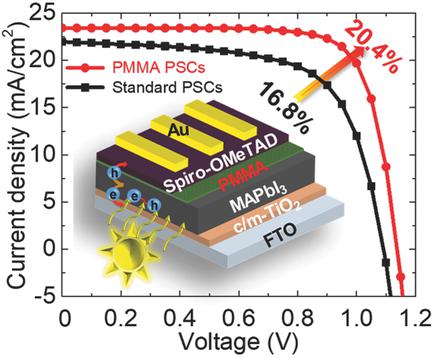当前位置:
X-MOL 学术
›
Adv. Mater. Interfaces
›
论文详情
Our official English website, www.x-mol.net, welcomes your
feedback! (Note: you will need to create a separate account there.)
Roles of Polymer Layer in Enhanced Photovoltaic Performance of Perovskite Solar Cells via Interface Engineering
Advanced Materials Interfaces ( IF 4.3 ) Pub Date : 2017-12-21 , DOI: 10.1002/admi.201701256 Fengjiu Yang 1 , Hong En Lim 1 , Feijiu Wang 2 , Masashi Ozaki 3 , Ai Shimazaki 3 , Jiewei Liu 3 , Nur Baizura Mohamed 1 , Keisuke Shinokita 1 , Yuhei Miyauchi 1 , Atsushi Wakamiya 3 , Yasujiro Murata 3 , Kazunari Matsuda 1
Advanced Materials Interfaces ( IF 4.3 ) Pub Date : 2017-12-21 , DOI: 10.1002/admi.201701256 Fengjiu Yang 1 , Hong En Lim 1 , Feijiu Wang 2 , Masashi Ozaki 3 , Ai Shimazaki 3 , Jiewei Liu 3 , Nur Baizura Mohamed 1 , Keisuke Shinokita 1 , Yuhei Miyauchi 1 , Atsushi Wakamiya 3 , Yasujiro Murata 3 , Kazunari Matsuda 1
Affiliation

|
Perovskite solar cells (PSCs) have attracted intensive attention as the most promising next‐generation photovoltaic technology because they both enable accelerated development of photovoltaic performance and are compatible with low‐cost fabrication methods. The strategy of interface engineering of the perovskite layer in PSCs is expected to result in further enhancement of the power conversion efficiency (PCE) of PSCs via minimizing the charge recombination loss. Here, a high current–voltage (stabilized power output) PCE of 20.4% (19.9%) in CH3NH3PbI3 PSCs under reverse scanning conditions is demonstrated by incorporating a solution‐processed polymer layer of poly(methyl methacrylate) (PMMA) between the perovskite photoactive layer and the hole transport layer. Moreover, steady‐state and time‐resolved photoluminescence spectroscopy and impedance spectroscopy are used to reveal the mechanism of the enhancement of the photovoltaic performance and its stability by the PMMA layer in a CH3NH3PbI3 PSC device. The morphology modification, surface passivation, and protection of the perovskite layer by the insulating PMMA layer substantially contribute to the enhancement of photovoltaic performance and its stability, despite a slight reduction of the charge extraction efficiency. The demonstrated high PCEs and insights obtained into the working mechanism of the PMMA layer pave the way for the industrial application of CH3NH3PbI3 PSCs.
中文翻译:

通过界面工程,聚合物层在增强钙钛矿型太阳能电池的光伏性能中的作用
钙钛矿太阳能电池(PSC)作为最有前途的下一代光伏技术受到了广泛关注,因为它们既可以加速光伏性能的发展,又可以与低成本制造方法兼容。PSC中钙钛矿层的界面工程化策略有望通过最小化电荷复合损失来进一步提高PSC的功率转换效率(PCE)。在此,CH 3 NH 3 PbI 3中的高电流-电压(稳定功率输出)PCE为20.4%(19.9%)通过在钙钛矿光敏层和空穴传输层之间引入聚甲基丙烯酸甲酯(PMMA)的溶液加工聚合物层,可以证明在反向扫描条件下的PSC。此外,使用稳态和时间分辨的光致发光光谱和阻抗光谱来揭示CH 3 NH 3 PbI 3中的PMMA层增强光伏性能及其稳定性的机制。PSC设备。尽管电荷提取效率略有降低,但绝缘的PMMA层对钙钛矿层的形貌改性,表面钝化和保护基本上有助于提高光伏性能及其稳定性。已证明的高PCE和对PMMA层工作机理的深入了解为CH 3 NH 3 PbI 3 PSC的工业应用铺平了道路。
更新日期:2017-12-21
中文翻译:

通过界面工程,聚合物层在增强钙钛矿型太阳能电池的光伏性能中的作用
钙钛矿太阳能电池(PSC)作为最有前途的下一代光伏技术受到了广泛关注,因为它们既可以加速光伏性能的发展,又可以与低成本制造方法兼容。PSC中钙钛矿层的界面工程化策略有望通过最小化电荷复合损失来进一步提高PSC的功率转换效率(PCE)。在此,CH 3 NH 3 PbI 3中的高电流-电压(稳定功率输出)PCE为20.4%(19.9%)通过在钙钛矿光敏层和空穴传输层之间引入聚甲基丙烯酸甲酯(PMMA)的溶液加工聚合物层,可以证明在反向扫描条件下的PSC。此外,使用稳态和时间分辨的光致发光光谱和阻抗光谱来揭示CH 3 NH 3 PbI 3中的PMMA层增强光伏性能及其稳定性的机制。PSC设备。尽管电荷提取效率略有降低,但绝缘的PMMA层对钙钛矿层的形貌改性,表面钝化和保护基本上有助于提高光伏性能及其稳定性。已证明的高PCE和对PMMA层工作机理的深入了解为CH 3 NH 3 PbI 3 PSC的工业应用铺平了道路。










































 京公网安备 11010802027423号
京公网安备 11010802027423号